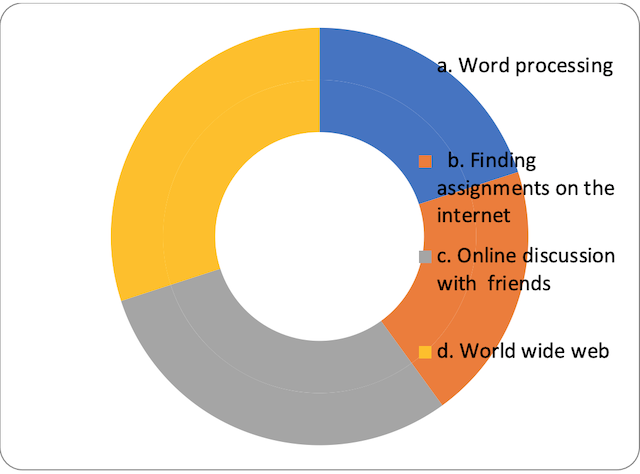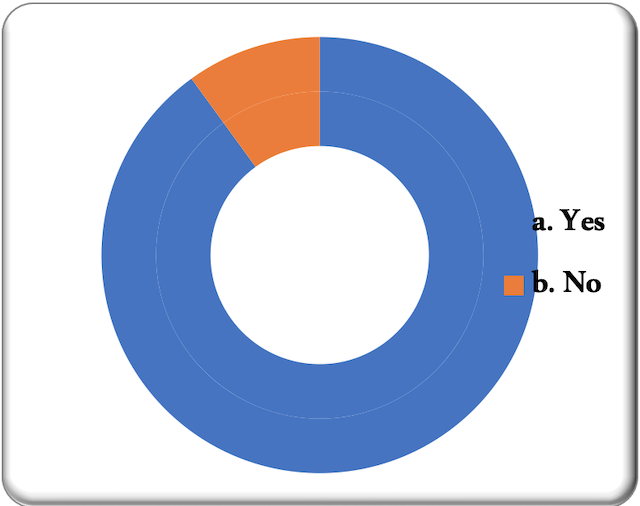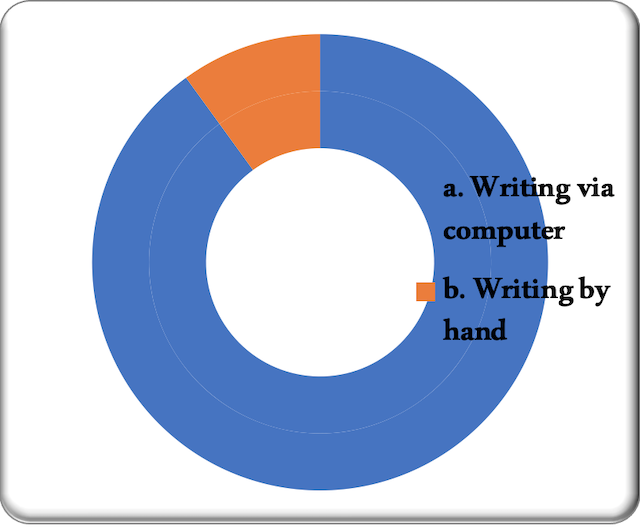Introduction
Generally speaking, writing is one of the most important skills that students need to acquire in order to master any language; unfortunately, many of them find difficulties in writing and even in having opportunities to write. Therefore, many researchers (Swain, 1985; Harmer, 2007; Sotillo, 2000) tried to identify the best methods to teach writing for EFL learners. Actually, many of us may have noticed that technology has expanded rapidly becoming a crucial component of our world population. The use of technology within the spread of internet and personal computers has carried a very important shift in language learning and teaching writing. Hence, teachers are trying to explore new ways to promote EFL learners’ writing achievement. We need to understand that the tendency towards the integration of CMC can play an essential role to boost EFL learners’ communication skill specially writing.
Therefore, The present study tries to answer the following questions:
-
What are the students’ perceptions towards the use of computer - mediated communication (CMC) as a tool to enhance their writing skill?
-
Are the students aware about the use of computer- mediated communication (CMC) as a tool of motivation to write in a better way?
This study tends to understand the needs of EFL learners and to introduce new method to help them write in a better way. It aims to explore EFL learners’ perceptions about the use of computer- mediated communication to enhance their writing ability appropriately. Hence, this study attempts specifically to demonstrate students’ perceptions towards the use of CMC to achieve better in writing.
1. Literature Review
1.1. Computer-Mediated Communication (CMC)
Computer-mediated communication or net speak as a new area of linguistic investigation has drew the attention of many researchers. Over the past 10 years, many articles have been published about internet – based language use. Recently, CMC has matured as a genre of its own. Herring (1996) defined CMC as: “communication that takes place between human being via the instrumentality of computers” and characterizes it as: “an important new communication modality that is increasingly permeating everyday life in industrialized societies” (p. 1). Ooi (2002) emphasized the multi-modal nature of CMC and he redefined it as: “a mode of human communication that centrally involves the computer as the medium and made via hybrid of speech writing graphics and orthography” (p. 91).
December (1996) said that CMC is a process for people to create, exchange, and perceive information via network communication technologies which make encoding, transmitting, and decoding messages easy. In the same vein, Harmer (2007) claimed: “what has changed recently, though, is that students can do things they were unable to do before thanks to technical innovation” (p. 31).
CMC is communication mediated through the computer and can take synchronous such as video, conferencing, text-based chat or voice chat … etc in which learner can communicate with others spontaneously as well as asynchronous like electronic e-mail, e-cards … etc. CMC forms share the following criteria: anonymity, written form communication, slower than spoken, editing capacities, can be used spontaneously, options to re-read messages and post them simultaneously (Böhlke, 2003; Gonzalez-Bueno, 1998; Kern, 1995). Computers in CMC language instruction is used as an aid for communicative interaction. So, CMC seems similar to communicative approaches to foreign language teaching. In a communicative approach, comprehension of input – listening and reading are essential to the whole process of language acquisition. Yet, Swain (1985) noticed that comprehension of input is not enough for acquiring language. Writing and speaking as learner output is also necessary aspect of language acquisition. The use of computers in CMC activities gives input and output which are both essential for second language learners’ development (Sotillo, 2000).
Some teachers have chosen e-mail or key pal (pen pal) as a tool for teaching second language. Learners can write e-mail to native or no-native partners. They can exchange their works with a partner as an aid to get accurate information on vocabulary, grammar, or cultural points. Kern and Warschauer (2000) stated that socio-cultural engagement is critical in language learning and learners cannot develop very far alone. Learning a language is a process in which the learner has to be indulged in through social contact. CMC offers the tools that make the social contact in language classes possible and fruitful. In well-executed email program, learners can enhance their writing and reading ability, raise their awareness of the world around them, and encourage motivation. Robb (1996) confirmed that electronic pen pals can motivate learners not only in improving certain skill areas, but it can affect their attitudes towards the target language and culture. Learners have the opportunity to use the foreign language outside classroom.
Studies on educational technology demonstrated that using internet in teaching second languages has the power to motivate teachers and students, and raise students’ participation in classroom tasks (Warschauer, 1996). Research into text-based chat environments for EFL has proved that online communications with intercultural chat partners have notably different features from that of class. the research of Hudson and Bruckman (2002) revealed that : ‘‘communication with intercultural partners in online chat provides a student-centred learning environment where students feel more free and not reluctant to interact with others” (p. 109). They found that “almost real time nature of chat.” (p. 109) provides a mixture of benefits that emerges from both face-to-face conversation and e-mail (asynchronous) interaction.
1.2. CMC and Language Learning
Most of the former researches in CMC compared face – to-face interaction with CMC context, and inspected the effects that each had on different features of language learning. Beauvois (1992) and Chun (1994) demonstrated that CMC boosts more target language use. For example, accountability; when student is exposed to his or her own language production on the screen of the computer, the showing of transcripts as proof of conversation, and the communication with slower speed may all lead to the development in the target language use. Chun (1994) claimed that CMC improves the writing capacities of EFL learners, and Donaldson and Kotter (2003) argued that the lack of paralinguistic factors and the considerable need to say everything in written form would promote language development.
Many researchers in CMC (Beauvois, 1992; Chun, 1994; Kern, 1995, and Warschauer, 1996) agreed on the benefit of CMC in language development; however, its use depends on the complexity of language production and the accuracy of postings in CMC. The following advantages of CMC over classroom conversation were presented by early CMC researchers:
-
Offers a voice to those who do not have (Baston, 1988);
-
Enhances language production (Beauvois, 1992; Kern 1995);
-
Reduces teacher authority (Beauvois, 1998);
-
Adjusts participation especially for students who are shy (Beauvois, 1992 & Bump, 1990);
-
Enhances readiness to speak about topics freely and honestly (Beauvois, 1992);
-
Boosts student motivation (Batson, 1998; Beauvois, 1992; Bump, 1990);
-
Reduces anxiety (Beauvois, 1992);
-
Enhances target language use (Beauvois, 1992; Kelm, 1992);
-
Develops reading comprehension (Kelm, 1992);
-
Increases written ability (Chun, 1994);
-
Improves language output (Darhower, 2002);
-
Improves interactive discourse (Abrams, 2001);
-
Enhances student attitude toward language learning (Blake, 2000; Warschauer, 1996);
-
Affords a great sequence for language functions through discourse (Chun, 1994).
1.3. CMC Tools in Language Teaching and Learning
In fact, the use of computers as a tool in teaching and learning a language provides a good way to communicate interactively. Hence, computer- mediated communication (CMC) and communicative approaches show a close relationship in teaching a foreign language. In a communicative approach, the understanding of input, listening and reading are essential for the complete acquisition of the language. Nevertheless, Swain (1985) noticed that the input comprehension is not enough for acquiring a language. Student output as writing and speaking is also predominant elements of language acquisition. The activities in CMC language instruction afford both input and output that are important in the development of students’ second language (Sotillo, 2000). Hampel and Hauck (2004) came to the conclusion that internet-based tasks allow learners to interact and to negotiate meaning with others as they require receiving and delivering information. Learners have to comprehend inputs and to deliver comprehensible outputs via speaking and writing.
Computer- mediated communication can be either synchronous (text-based chat or voice chat, video conferencing…) where second language learner can interact with other synchronously (spontaneously). The other kind of CMC is asynchronous (e-cards, Bulletin boards, electronic mail, and blistery mailing lists…) in which second language students can form messages when they are not on-line. Abrams (2003) mentioned the similarities and differences between synchronous and asynchronous as follows:
-
Similarities: Extensive learner-to-learner (or learner-learner-teacher) negotiation of meaning; more ‘talk’ time per learner than oral classroom communication; increased amount of output results in richer and more diverse lexicon; written code; register between those of written and oral styles of communication.
-
Differences: Relatively immediate responses in SCMC (synchronous computer mediation communication) vs. Extended planning, encoding, decoding time in ACMC (asynchronous computer mediation communication); use of outside recourses cumbersome in SCMC versus the use of outside recourses not limited in ACMC; social immediacy of interlocutors in SCMC versus interact ants not ‘immediately’ present (p. 159).
Some language teachers who have used internet as an aid in teaching a second language have selected e-mail or key pal (pen pal) exchanges for their learners. For instance, learners can write e-mails to native or non-native intercultural partners. They can work collaboratively and use their exchange partner as an aid to have correct information on grammar, vocabulary, or cultural items. Warschauer and Kem (2000) asserted that socio-cultural contact is determinative in language learning. Language learning is not a procedure in which a student can develop individually; it is a procedure that students have to be indulged in through social interaction. CMC makes social communication in language classrooms accessible and productive.
In a well-planned e-mail curriculum, students can progress their writing and reading capacities, raise awareness of the world around them, and encourage communication (Trokeloshvili and Jost, 1997). According to this view, electronic pen pals can stimulate learners to increase specific skill areas and also influence learners’ attitudes towards the target language and culture. Learners have opportunities to use the foreign language outside the classroom (Robb, 1996).
Studies on educational technology demonstrated that the application of internet in teaching second language has the capacity to activate students and teachers (Frizler, 1995; Warschauer & Whittaker, 1997), and enhance students’ engagements in classroom tasks (Ortega, 1997; Signhal, 1997; Warschauer, 1996). Especially in a classroom situation, which is dominated by teachers and students who may hesitate to join the tasks or interact with other students to ameliorate their second language capacities. Research has shown that text- based chat environments for EFL have noticeably different features from conversation in the classroom. In Hudson’s and Bruckman’s study (2002), the results pointed that communication with intercultural partners in online chat generates a student-centred learning environment in which students feel comfortable in interacting with others.
2. Methodology
2.1. Data Collection Instrument
The data of this research was collected via a questionnaire. The aim of designing a questionnaire was to explore the general perceptions of students to CMC. The questionnaire consisted of four sections and each section engulfed a set of closed-ended questions. The SPSS is used to analyze the data gathered from the questionnaire.
2.2. Participants
This study was conducted in the department of English language and literature at Mohamed lamine Debaghine -Setif 2-University. The sample of the study consisted of 100 students out of 340 ones. The research is an exploratory in nature within a random sampling. The aim behind choosing second year students was because they were expected at the end of their academic year to write correctly at the level of paragraph, composition, and essay.
Section I: Participants’ Background Information
In the first section, all participants were requested to give background information. The items of this section were about how long they have been studying English, did they have a writing course, and how many sessions per a week was the course.
Section II: Participants’ Language Skills
In the second section, all participants were requested to give their views about their own language skills. There were four questions. The first one was about the participants’ rate in their English skills, the second one was about choosing the most difficult skill, the third one was about the skill that they mostly like to improve and the final one was about enjoying writing or no.
Section III: Participants’ Computer Availability and Use
In the third section, three questions were asked. One was about the availability of computers at home, the other one was about the use of computer to learn English, and the last one was about the different use of computers.
Section IV: Participants’ Perceptions towards the Use of Computer-Mediated Communication
In this section, we tended to know: whether communication technology was useful to learn a language, whether its use promoted students English writing abilities, and whether computer mediated communication learning could increase participants’ motivation and interest.
3. Analysis of Students’ Questionnaire
3.1. Section one: Background Information
Concerning the first and the second question, all the participants said that they have been studying English for 8 years and they have already experienced a writing course. That is to say, all the participants had a long exposure to the language which was 8years and they were already passing through a writing course to learn how to write. The last question showed that all the participants had the writing course two sessions per week which means a less opportunity to write a lot.
3.2. Section Two: Students’ Language Skills
Figure N° 1. Students’ Rate in their English Skills
Table1. Students’ Rate in their English Skills
|
Options |
Numbers |
Percentages |
|
Very good |
0 |
0% |
|
b. Good |
20 |
20% |
|
c. Average |
30 |
30% |
|
d. Very poor |
50 |
50% |
|
Total |
100 |
100% |
Figure N° 2. The Difficulty of Language Skills
Table2. The Difficulty of Language Skills
|
Options |
Numbers |
Percentages |
|
a. Listening |
0 |
0% |
|
b. Reading |
0 |
0% |
|
c. Speaking |
40 |
40% |
|
d. Writing |
60 |
60% |
|
Total |
100 |
100% |
Figure N° 3. Language Skills mostly Like to Improve
Table3. Language Skills mostly Like to Improve
|
Options |
Numbers |
Percentages |
|
a. Listening |
0 |
0% |
|
b. Reading |
0 |
0% |
|
c. Speaking |
40 |
40% |
|
d. Writing |
60 |
60% |
|
Total |
100 |
100% |
Figure N° 4. Enjoying Writing
Table 4. Enjoying Writing
|
Options |
Numbers |
Percentages |
|
a. Yes |
35 |
35% |
|
b. No |
65 |
65% |
|
Total |
100 |
100 % |
3.3. Section III: Students’ Computer Availability and Use
Figure N° 5. Computer Availability
Table5. Computer Availability
|
Options |
Numbers |
Percentages |
|
a. Yes |
90 |
90% |
|
b. No |
10 |
10% |
|
Total |
100 |
100% |
Figure N° 6. Computer Use to Learn English
Table6. Computer Use to Learn English
|
Options |
Numbers |
Percentages |
|
a. Yes |
100 |
100% |
|
b. No |
0 |
0% |
|
Total |
100 |
100% |
Figure N° 7. The Different Uses of Computer
Table7. The Different Uses of Computer
|
Options |
Numbers |
Percentages |
|
a. Word processing |
20 |
20% |
|
b. Finding assignments on the internet |
20 |
20% |
|
c. Online discussion with friends |
30 |
30% |
|
d. World wide web |
30 |
30% |
|
Total |
100 |
100% |
3.4. Section IV: Students’ Perceptions towards the Use of Computer Mediated-Communication
Figure N° 8. The Usefulness of Communication. Technologies to Learn English
Table 8. The Usefulness of Communication Technologies to Learn English
|
Options |
Numbers |
Percentages |
|
a. Yes |
100 |
100% |
|
b. No |
0 |
0% |
|
Total |
100 |
100% |
Figure N° 9. Students’ Beliefs about the Integration of Computer-Assisted Language Learning to Promote their English Writing Abilities
Table9. Students’ Beliefs about the Integration of Computer-Assisted Language Learning to Promote their English Writing Abilities
|
Options |
Numbers |
Percentages |
|
a. Yes |
90 |
90% |
|
b. No |
10 |
10% |
|
Total |
100 |
100% |
Figure N° 10. Enjoying Writing via Computer rather than by Hand
Table10. Enjoying Writing via Computer rather than by Hand
|
Options |
Numbers |
Percentages |
|
a. Writing via computer |
90 |
90% |
|
b. Writing by hand |
10 |
10% |
|
Total |
100 |
100% |
4. Discussion and Recommendations
-
Students’ questionnaire was designed to explore their perceptions towards the use of CMC to foster their writing performance. Also, the aim behind the questionnaire was to see whether students were aware about the use of computer mediated- communication (CMC) as tool to motivate them to write more and more. The results show that the students lacked opportunities to write in the target language since they had only two sessions a week which was not enough for them to practice writing. Emig (1977) addressed the importance of writing as a process that allows us to write what we think. It is a process that helps to reconsider and refine ideas. Thus, students seem in need to have another extra laboratory session where s/he is exposed to computer to do writing tasks. It can even be done home if the laboratories are not available.
-
Also, the questionnaire’s results report that they were really struggling with the writing skill and according to them it was one of the difficult skills along with the speaking one. This is why, they exhibited a poor writing performance and they put a highest priority on enhancing it. Moreover, they thought that writing is a hard skill and this is one of the reasons behind losing motivation. According to students, writing is considered the most problematic of the skills to master (Swarbrick, 2002).
-
In addition, many of the students previously indicated that computer is available at their homes. Noticeably, the wide spread tendency towards integrating computer in our daily life becomes a need nowadays. Hence, our participants are familiar with using computer and internet resources. It is obvious that the growth of technology use through internet in its different patterns in language education has become a norm more than exception. The use of technology in foreign language classes can offer a meaningful and intriguing approach for language teaching and learning. It encourages students to be more motivated as well as to be more engaged in speaking, reading, listening, and writing (Ilter, 2000).
-
Moreover, the results suggest that students used computers to do word processing, finding assignments on internet, and discussing online with others. Therefore, it was clear that students used computer to do different tasks which means that they were aware of the importance of using CMC in their social and academic context. Hampel and Hauck (2004) came to the conclusion that internet-based tasks allow learners to interact and to negotiate meaning with others as they require receiving and delivering information.
-
Furthermore, the data gathered from students’ questionnaire demonstrate students’ positive perceptions towards the use of communication technologies to promote their English language learning. The results indicate that is highly important to incorporate communication technologies while learning to write. Students can use computers and internet to complete their writing assignments in a better way. Through using computers and internet, they are able to check correct spelling and have a deep insight about language vocabulary and grammar which can ultimately be of a great help to boost their writing proficiency. Beauvois (1992) and Chun (1994) demonstrated that CMC boosts more target language use. For example, accountability; when student is exposed to his or her own language production on the screen of the computer, the showing of transcripts as proof of conversation, and the communication with slower speed may all lead to the development in the target language use.
Conclusion
This paper has given an idea about computer-mediated communication that can help in learning English particularly writing skill. The findings of this study indicate that EFL students have positive perceptions towards the application of computer-mediated communication to enhance their writing ability. However, they don’t realize how to incorporate CMC in order to develop their writing products. Through CMC, learners can correct their spelling and grammatical mistakes and can enlarge their background in vocabulary easily. Generally, this study suggests that the integration of CMC can change the progress of classroom traditional environment precisely in writing achievement. Hence, it remains to know how this new tool (CMC) can significantly help learners to become competent writers.










